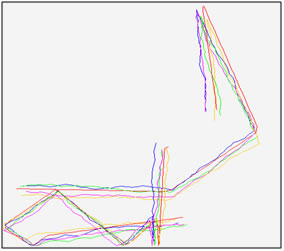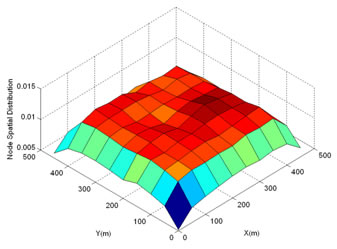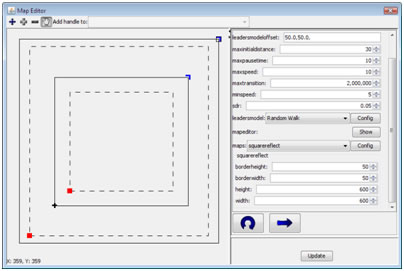Reference Point Group Model (nomadic)
In line with the observation that the mobile nodes in MANET tend to coordinate their movement, the Reference Point Group Mobility (RPGM) Model is proposed in . One example of such mobility is that a number of soldiers may move together in a group or platoon. Another example is during disaster relief where various rescue crews (e.g., firemen, policemen and medical assistants) form different groups and work cooperatively.
In the RPGM model, each group has a center, which is either a logical center or a group leader node. For the sake of simplicity, I assume that the center is the group leader. Thus, each group is composed of one leader and a number of members. The movement of the group leader determines the mobility behavior of the entire group. Initially, each member of the group is uniformly distributed in the neighborhood of the group leader. Subsequently, at each instant, each node has a speed and direction that is derived by randomly deviating from that of the group leader. The movement in group mobility can be characterized as follows:

SDR is the Speed Deviation Ratio and ADR is the Angle Deviation Ratio. SDR and ADR are used to control the deviation of the velocity (magnitude and direction) of group members from that of the leader. Therefore, model parameters will be ADR, SDR, initial distance (members initial distance from the leader node), and group size which determines number of group nodes.
I used Random Walk Mobility Model for motion behavior of leader node in each group as the default model, but you can select any model for the leader behavior. For example, you can use a Multi Model or a group model for leaders. The model’s hierarchy can continues to infinite number of levels.
I also proposed a scheme to protect nodes to pass the simulation regions. When the leader node reaches simulation region it reflects using reflection rule I explained in Random Walk Mobility Model and Group member nodes are bounded to simulation region.
This model adds two columns in the trace files: “GroupNumber” tells group number of the node, and “Is Leader” shows if the corresponding node is the leader of its group. While these information could be helpful, when you are combining group models, for example when you set a group model as the mobility model of the leader nodes, makes a complex trace. You can turn off this extra trace feature by unchecking the “extratrace” parameter.
The following figure shows traveling pattern of two groups with 5 nodes with average speed=20m/s, SDR=0.05, ADR=0.05, using RPGM Mobility Model.

Traveling pattern of Mobile Nodes in RPGM Mobility Model
As we can see in the next figure, the node spatial distribution is similar to Random Walk Mobility Model because the leader node in each node travels with Random Walk Mobility Model.

Spatial Node Distribution in RPGM Mobility Model
RPGM is a complex model because it has a model parameter (Group Leader’s model). As a result, in its map editor, you can see map handles for its map beside the map of its internal model. Moreover, there is an “offset” map handle  which states relative position of map of internal model to the base map. Note that internal map could not have a point out of the base map. This criterion has been implemented by asking the base map to check if it can include some border points of the map of internal model. which states relative position of map of internal model to the base map. Note that internal map could not have a point out of the base map. This criterion has been implemented by asking the base map to check if it can include some border points of the map of internal model.

Group Models' Map Editor (with a Square Reflect map for its leaders' model) |